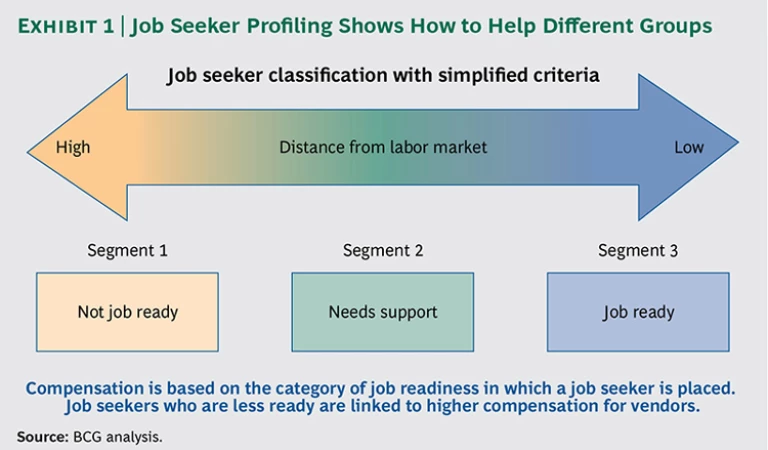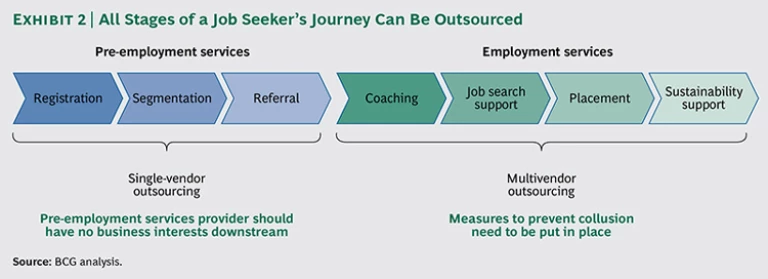It’s a staggering figure: more than 200 million people around the world are unemployed, according to the United Nations International Labour Organization. That number, still well above pre-2009 figures, reflects the continued repercussions of the global economic crisis.
As governments struggle to reduce unemployment, they are increasingly tapping the private sector to manage the vital task of helping job seekers find employment. The hope: that the private sector not only improves the value-for-money trade-off for these services amid budget pressures but also innovates to provide more effective and efficient employment services.
Unfortunately, governments often don’t know how to work successfully with private-sector employment-service providers. Many stumble. Among the common pitfalls: setting up agreements that allow private-sector providers to “game the system” through moves such as cherry-picking the most easily placed job seekers and “parking” candidates who are particularly tough to place.
To address the challenges, The Boston Consulting Group has identified five success factors for governments that are working with private-sector employment-service providers:
- Focusing on the right objectives based on the goal, which might be to increase placement rates or to reduce overall costs
- Maximizing the effectiveness of job seeker segmentation to match the right resources and services to the right groups
- Designing compensation rules that block gaming of the system and promote success
- Understanding and enhancing the power of competition in the employment services market
- Managing vendor relationships effectively and comprehensively
Deploying these best practices consistently can help governments maximize the impact of the employment services they provide. Some governments are finding reasonable success in this area now, but few are realizing the full potential of those relationships—and others are failing outright.
The Unemployment Challenge
Unemployment remains a critical challenge around the world, with the nations of the Organisation for Economic Co-operation and Development spending some $600 billion every year on unemployment benefits and services. (See Strength in Numbers: Using Data-Driven Segmentation to Transform Government Services , BCG Focus, November 2013.) In the developed world, countries are looking for ways to improve the success and cost-effectiveness of services that help job seekers find sustainable employment. Meanwhile, many developing nations need to set up such services from scratch or to improve the sophistication of their often very basic support for the unemployed.
Regardless of their starting point, governments have been seeking innovative ways to provide employment services. In many cases, this involves drawing on the expertise of the private sector. The US and the UK, for example, outsourced some employment services more than 25 years ago, and other countries (such as Australia, France, and Germany) made that move in the 1990s or the first decade of the twenty-first century. More recent high-profile efforts to revamp employment services include the UK’s Work Programme, which was introduced in 2011 and outsourced much of the government’s welfare-to-work efforts for the long-term unemployed to the private sector. In total, about one-third of European Union expenditures on job placement activities go to external providers, with the share in some countries, including the UK and the Netherlands, as high as two-thirds. Private-sector employment agencies globally are a $525 billion industry with more than 1.5 million workers.
That shift is likely to accelerate in the future—exacerbating the challenge given the historic learning curve for most countries dealing with such changes. But there are ways to move countries more quickly along that curve.
Five Success Factors
Drawing the private sector into the provision of employment services poses both tremendous opportunities and significant challenges. On the basis of our experience working with governments of both developed and developing nations on three continents, we have identified five success factors for effective arrangements with private-sector employment-service providers.
Focus on the Right Objectives
Traditionally, employment services have focused on objectives such as the number of training or job counseling sessions provided, measuring what we call “outputs.” Increasingly, however, even tracking the number of people placed in jobs is considered an inadequate measure. Rather, governments are more focused on “outcomes,” measures such as the percentage of job seekers who find lasting employment. This shift toward a focus on outcomes is complex, however. For example, stakeholders in the UK are debating whether long-term contracts with service providers should take into account the wages earned by individuals placed in new jobs.
Regardless of how the objectives are measured, it is crucial to spell them out clearly at the beginning of the relationship. In some cases, the goal will be to improve the percentage of job seekers finding sustainable employment; in others, to lower costs; in still others, to promote innovation.
Maximize the Effectiveness of Job Seeker Segmentation
In order to successfully segment the population of job seekers, governments need to understand the different levels and types of assistance that different groups of job seekers require. They also need to establish a mechanism for directing the right resources to each group—and this can be a significant stumbling block even for governments that have been segmenting job seekers effectively for years or decades. Depending on the degree of outsourcing, segmentation may be best achieved through government-driven rules or a payment structure that incentivizes private-sector providers to allocate resources properly.
Successfully tailoring services to job seekers’ needs starts with answering a number of questions, including the following:
- What is the best channel—face-to-face or online sessions, for example—for communicating with each customer group?
- Which groups are best served by a straightforward job-matching service, and which groups require more extensive assistance, such as career counseling or training in job search techniques?
When it comes to segmenting job seekers, government agencies often use “job seeker profiling.” (See Exhibit 1.) It is not the only method available, but it is the most widely used and proven approach. (See “Time Will Tell: Segmentation Based on Time to Placement.”) Job seeker profiling involves creating segments of the population on the basis of factors such as education level and job history.
TIME WILL TELL: SEGMENTATION BASED ON TIME TO PLACEMENT
The “accelerator cohort” approach to segmentation holds great promise—but also comes with significant challenges. In this approach, job seekers are not classified at the outset of the job search process. Rather, they are naturally segmented based on the time it takes to place them in a job. The first group to be placed within a predetermined period of time makes up one segment, the next group placed within a somewhat longer period makes up a second segment, and so on.
Essentially, job seekers are segmented into groups according to the degree of difficulty associated with their case. Different compensation levels are set for assisting individuals in each segment, the assumption being that finding jobs for the groups placed later was more challenging.
This might sound like a simple approach, but it actually requires significant data and insight on the part of governments. To set appropriate prices for the payment associated with each cohort, governments must have a rich set of historical data on job seekers, extensive experience in working with private-sector employment-service providers, and a good understanding of the cost curve for each vendor in each region. This makes for a very data-demanding analysis that is easily susceptible to miscalculation should any element of the vendor’s costs or any key factor in the labor market change. Such a miscalculation could quickly lead to either large overpayment for services or to less-than-optimal payments that create a significant disincentive for the service provider.
That’s why the accelerator cohort approach has yet to be adopted by major governments. Until the concept is proven, it is likely to remain more theory than practical tool.
For example, the government in Saudi Arabia uses information on factors such as job history, education, and marketable skills to place job seekers into three categories: green for those who can likely be placed in a job quickly, yellow for those who need a bit more support to find work, and red for those who will need significant training or support to be placed. And in Australia, unemployed workers seeking government support are segmented according to the government’s Job Seeker Classification Instrument, a tool that considers age, occupation, employment history, and other factors. That segmentation is used to determine job readiness, and private-sector employment-service providers are paid on the basis of the level of difficulty associated with finding employment for the different segments.
Design Compensation Rules
Smart compensation rules are critical. Well-designed rules will prevent gaming of the system—something that has plagued a number of systems around the world—and incentivize service providers appropriately.
The Risk of Provider Gaming. There are three ways to game an outcome-based system for employment services.
A company can cherry-pick, proactively pushing to have job seekers who will be relatively easy to place assigned to its service programs. This allows vendors to minimize their cost of training per successful placement but marginalizes tougher job-seeker cases, creating a problem for the government, which must continue to support those individuals for a longer period of time.
Another approach is “creaming,” in which a company focuses its employment-service efforts on the pool of candidates who can be placed quickly, a move that helps the company collect outcome-based payments sooner and minimizes the risk that the job seeker will find work by other means. In this case, easier cases find employment faster while harder cases have to wait.
And a service provider can game the system by “parking” individuals, deprioritizing employment-service efforts for assigned job seekers who are difficult to place until it has spare service capacity. The result: harder cases receive delayed or lower-quality service—or both.
These three forms of gaming serve different purposes: parking is a cost-cutting strategy for service providers, whereas cherry-picking and creaming are revenue generation strategies. Consequently, each form of gaming can be used on its own or in combination. Parking is often—but not always—the result of cherry-picking and creaming. For example, a company could provide all assigned job seekers with a normal level of service but devote bonus services to easier-to-place job seekers to get them into jobs faster (creaming). The company could also stop assisting job seekers who are difficult to place given the low probability of finding jobs for them (parking).
Arrangements that allow for gaming are likely to perform poorly. A case in point: An initiative in France in 2007 and 2008 used private-sector companies to deliver job search assistance. A subsequent analysis found that the private-sector effort had about half the impact of the government’s program. The likely reason for the divergence: companies were signing up large numbers of job seekers but then parking them by putting minimal effort into placing the
Promoting Success with Smart Compensation Rules. Compensation rules can be structured in three ways, depending on the situation and the government’s objectives:
- Fixed Payments. When payments are fixed, providers are paid a flat fee (based, for example, on their incurred costs) for assisting job seekers. The downside is obvious—providers might be disinclined to focus on efficiency and producing results—but fixed payments sometimes make sense. In markets that have few private employment-service operators, fixed payments can provide the start-up funding needed to build out the base of service providers. The approach can also work well when the objectives of the government and the organization in question—a charity, for example—are very well aligned.
-
Output-Based Payments. Payments based on specific activities make sense when the government has the data and evidence to know which specific services will produce certain desired outcomes. Without such insight at the government level, output-based payments risk inefficiency, a lack of focus on results, and gaming by providers. One government agency paid employment service providers for elements of the services rendered (outputs) rather than purely for outcomes. So, providers were paid when job seekers attended a training course. But job seekers could select from an assortment of training courses, and one of the most popular focused on becoming a fitness trainer; ultimately, though, market demand for a wave of new fitness trainers was limited. The outputs that the government paid for did not translate into the desired outcomes. The results reinforced for the government that its programs needed to be linked more to outcomes than to outputs.
Another consideration: when a government uses an output-based compensation system, employment service companies, which are tasked with managing the overall job-assistance effort, are handed an incentive to create related businesses that develop and deliver the specialized training programs that constitute the outputs. Any potential conflict of interest must be managed carefully.
-
Outcome-Based Payments. This approach makes sense when the service provider, rather than the government, has the best handle on the exact mix of services that should be provided to yield the desired outcome. In this scenario, the compensation rules should be established such that service providers are rewarded on the basis of the difficulty of placing each job seeker.
Of course, government leaders must keep certain issues in mind. Outcome-based payments tend to be more expensive for the government than output-based approaches. That’s because employment service providers are taking on greater risk by having their payments tied to results—and therefore they demand higher returns. Further, although an outcome-based approach keeps providers focused on results, governments must beware of opportunities for gaming the system. And governments should encourage transparency and data sharing between themselves and providers to ensure that the government understands what is working and what is not. Such insights can inform future efforts and ultimately enable the government to move some services to output-based payments.
In some cases, a blend of approaches will be warranted. Saudi Arabia, for example, encouraged the development of private-sector employment-service companies by using fixed-fee contracts. Now, with the sector fairly established, the government is gradually moving to an outcome-based model.
Australia’s outcome-based system includes compensation rules that incentivize providers to help job seekers find long-term employment. Employment service providers receive a placement fee when a job seeker finds work—and an additional “sustainability fee” if the job seeker stays in the new job for at least 13 weeks.
Understand—and Enhance—the Power of Competition
Governments understand that healthy competition not only fosters service quality but also improves the odds that the government is paying the right price for the right service and the intended outcomes. But simply supporting competition is not enough. Governments can take concrete steps to drive and enhance the competitive dynamic across the spectrum of employment services. They must not only support competition during the often-heated tendering process but also ensure that competition remains vibrant well after contracts have been awarded.
Although countries have different philosophies about which portions of the job search journey should be handled by the private sector, it is possible to outsource each step in that process. (See Exhibit 2.) However, outsourcing has to be carefully managed to ensure fair competition. For example, if the government plans to outsource across the entire process, the earlier stages of the journey, up to the referral to the specific service center, are best managed by a single provider that has no role in actually providing services. This ensures that both easy- and difficult-to-place job seekers are distributed across available vendors without bias.
Competition should be encouraged primarily in the latter stages, during the process of contracting with service providers and throughout the period when those services are being delivered. The way in which competition is promoted will depend in large part on the maturity of the private-sector employment-service market in a particular country or region.
Harnessing the Power of the Job Seeker. When there is a healthy number of private-sector players and a service provider’s performance is transparent, job seekers and governments can choose which service to use, shifting business toward providers that have achieved better results. Australia, for example, encourages competition among its employment-service providers through regular tendering processes and reporting KPIs such as success in placing job seekers and the quality of the services provided. Each employment-service provider is rated with a certain number of stars, information that the government can use in making future contracting decisions and that job seekers can use when selecting among employment service providers.
Jump-Starting Competition When Necessary. It is critical for governments to assess the degree of competition in various locations or service categories. Multiple providers may exist within one location—which helps to cultivate competition—or the number of players may be limited. In those cases, governments can enhance competition by tapping employment providers outside that region to provide services using telephone and Internet communications.
Comprehensively Manage Vendor Relationships
Although vendor management is a classic business issue, many government entities have limited expertise in managing their stable of vendors effectively, leading to overspending and underperformance. A key element of managing those relationships is the contract process. Government entities can quickly improve the cost-effectiveness of their service or product portfolio by instituting some key best practices for vendor contracts:
- Standardized Contracts. Specifications within contracts (such as contract length) and KPIs (such as minimum performance standards) should be similar across providers. And consequences should be defined for occasions when those minimum requirements are not met. Overall, the goal should be a clear and simple contract that creates the right incentives for both parties.
- Flexibility. An element within these standardized contracts should be a series of key clauses that provide the government with flexibility to add, subtract, or adapt provisions within the contract that might prove contrary to the spirit and objectives of the agreement. Although these flexibility clauses will rarely be used, they should be included to avoid any major unintended consequences.
- Extended Duration. Contracts should extend beyond a year or two, giving vendors more comfort about their initial investment and enough time to prove the value of their products or services.
- Accountability. Contract awards and renewals should be linked directly to provider performance.
- Transparency. All agreements should have clear measures of provider performance, and those metrics should be made available to all interested parties including the government, other providers, and job seekers.
Failure to embrace these principles can result in disappointing outcomes and poor vendor relationships. In one case, the government of a large developed country created a complex, 250-page contract that defined an extensive and specific list of service requirements for the vendor to meet. The vendor devoted excessive effort and attention not to actual service provision but to meeting its many specific legal requirements as closely as possible. Over time, the relationship between the vendor and the government came to focus more on the contract than on the service and its outcomes, leading to growing and mutual distrust and disappointment. The result: the vendor decided to minimize the services it provided, a move that in turn limited the requirements of the contract and therefore any liability in case of a breach of contract.
Private-sector partnership is an important lever for government entities to apply in providing employment services. The most successful governments will be those that effectively harness the innovative power of the private sector and put in place protections to ensure that those providers do not behave in ways that boost their bottom line at the expense of taxpayers.
This balanced approach should be built on a clear understanding of the objectives of the partnership with the private sector, sophisticated insight into the different needs of job seekers, and rules and compensation strategies that align the interests of the government and the private sector. At the same time, these relationships must be managed effectively, with private-sector providers accountable for their results, and with flexibility to allow the government and those providers to adapt to a changing environment. That will foster long term—and productive—partnerships.
Acknowledgments
The authors acknowledge Haikal Siregar, Kenneth Simons, and Andreina Varady for their contributions in research and analysis and Agnès Audier, Miguel Carrasco, Rainer Minz, and Philipp Carlsson-Szlezak for their contributions in the development of this report.










